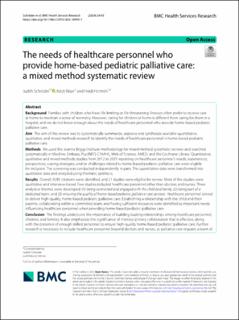The needs of healthcare personnel who provide home-based pediatric palliative care: a mixed method systematic review
Peer reviewed, Journal article
Published version
Permanent lenke
https://hdl.handle.net/11250/3111033Utgivelsesdato
2024Metadata
Vis full innførselSamlinger
Sammendrag
Background Families with children who have life-limiting or life-threatening illnesses often prefer to receive care
at home to maintain a sense of normalcy. However, caring for children at home is different from caring for them in a
hospital, and we do not know enough about the needs of healthcare personnel who provide home-based pediatric
palliative care.
Aim The aim of this review was to systematically summarize, appraise and synthesize available quantitative,
qualitative, and mixed methods research to identify the needs of healthcare personnel in home-based pediatric
palliative care.
Methods We used the Joanna Briggs Institute methodology for mixed method systematic reviews and searched
systematically in Medline, Embase, PsycINFO, CINAHL, Web of Science, AMED, and the Cochrane Library. Quantitative,
qualitative and mixed methods studies from 2012 to 2021 reporting on healthcare personnel’s needs, experiences,
perspectives, coping strategies, and/or challenges related to home-based pediatric palliative care were eligible
for inclusion. The screening was conducted independently in pairs. The quantitative data were transformed into
qualitative data and analyzed using thematic synthesis.
Results Overall, 9285 citations were identified, and 21 studies were eligible for review. Most of the studies were
qualitative and interview-based. Few studies included healthcare personnel other than doctors and nurses. Three
analytical themes were developed: (1) being connected and engaged with the child and family, (2) being part of a
dedicated team, and (3) ensuring the quality of home-based pediatric palliative care services. Healthcare personnel strived
to deliver high-quality, home-based pediatric palliative care. Establishing a relationship with the child and their
parents, collaborating within a committed team, and having sufficient resources were identified as important needs
influencing healthcare personnel when providing home-based pediatric palliative care.
Conclusion The findings underscore the importance of building trusting relationships among healthcare personnel,
children, and families. It also emphasizes the significance of interdisciplinary collaboration that is effective, along
with the presence of enough skilled personnel to ensure high-quality home-based pediatric palliative care. Further
research is necessary to include healthcare personnel beyond doctors and nurses, as palliative care requires a team of professionals from various disciplines. Addressing the needs of healthcare personnel can ensure safe and professional
palliative care for children at home.

